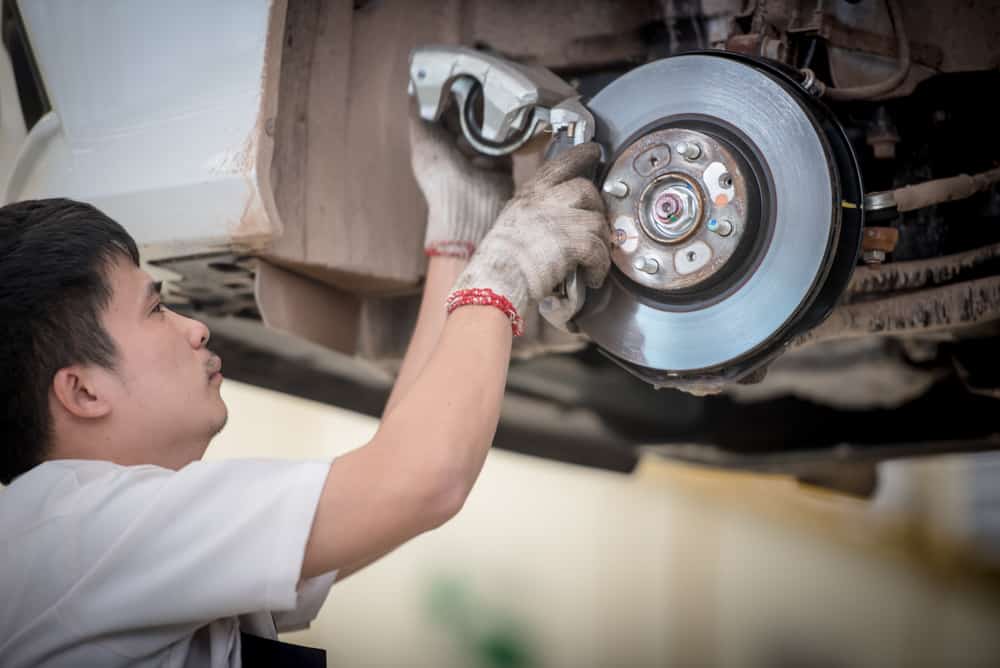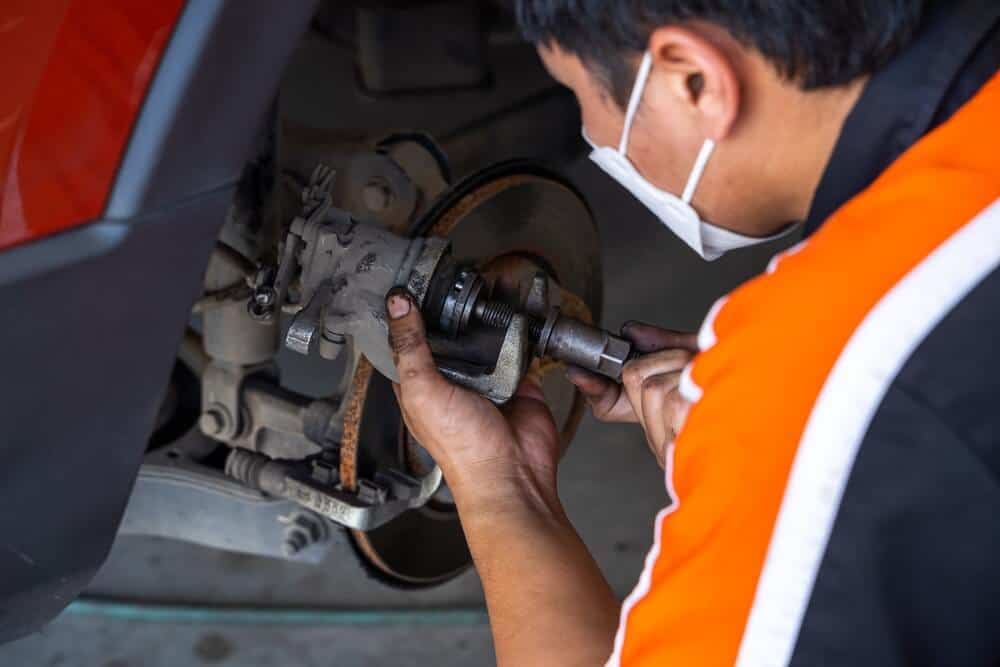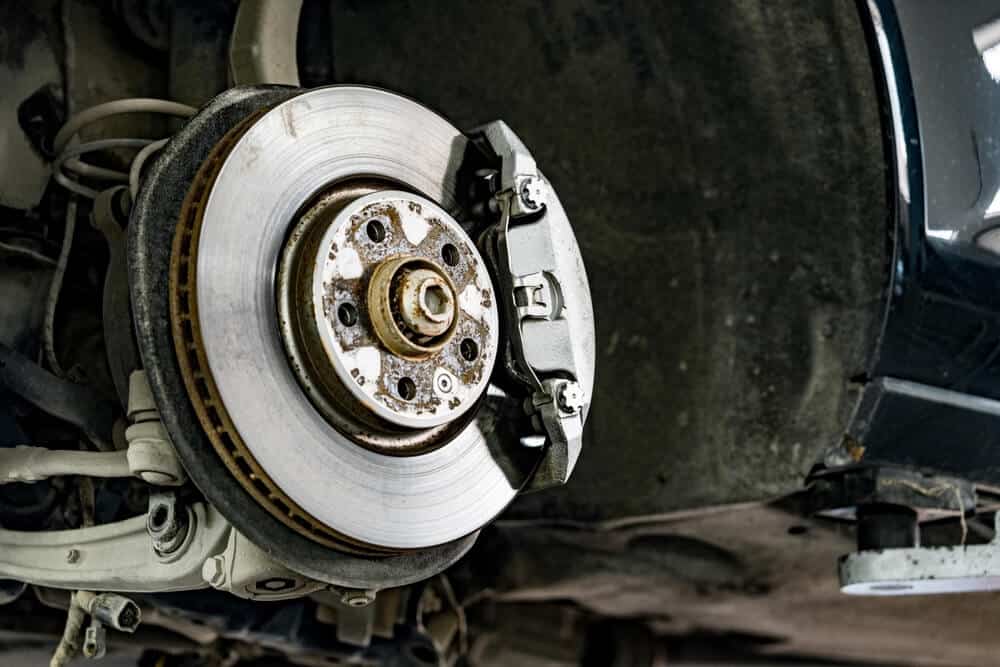If your brake rotors are squealing, shaking, or not slowing the vehicle as they should be, it’s time for new ones. In most cases, you’ll need new brake rotors about every 50-70,000 miles.
When you do, you can expect to replace them as a set with the brake pads. It’s also always a great idea to replace both rotors on the axle in question at once, so your brakes have the same amount of friction on both sides.

The average cost of replacing a brake rotor is about $150. That includes about $3-$100 in parts and about an hour of labor. However, you’ll normally have to replace both at once. So, you can expect costs to range between $250 and $800.
The table below shows a quick price comparison of brake rotor replacement cost estimates from reputable suppliers:
| Supplier | Brake Rotors (set) | Labor |
|---|---|---|
| YourMechanic | $212-$322 | $150-$160 |
| Midas | $220-$330 | $180-$280 |
| Jiffy Lube | $150-$380 | $189-$290 |
| Pep Boys | $174.99-$329.99 | $99-$380 |
| Walmart | $40-$393 | NA |
| Amazon | $30-$10,623 | NA |
Compare Car Warranty Quotes For Free & Save Big!
Topics
How Much Does Brake Rotor Replacement Cost?*
If you’re replacing brake rotors, the largest cost factor is usually labor. That’s because you have to take the wheels off.
You’ll also have to factor in replacing both rotors at once. And, most mechanics will want to replace the calipers or shoes at the same time to ensure your brakes are in good condition.
If you’re replacing “just” the rotors, the following estimates include replacing the rotors on the front axle in several popular vehicles.
| Vehicle | Brake Rotor Cost | Labor Cost |
|---|---|---|
| Honda Pilot | $158-$220 | $73-$128 |
| Honda CRV | $150-$230 | $99-$156 |
| Ford Explorer | $200-$330 | $158-$260 |
| Toyota 4Runner | $139-$228 | $85-$190 |
| BMW x3 | $189-$275 | $100-$245 |
| Subaru Forester | $189-$320 | $99-$254 |
| Ford F150 | $164-$212 | $95-$134 |
| Mazda 3 | $97-$220 | $105-$198 |
| Honda Civic | $16-$2303 | $99-$145 |
| Toyota Camry | $202-$264 | $92-$127 |
*Note: Prices are estimates and were correct at the time of writing (March 2022). Cost estimates may have changed since, our figures should be used as a starting point for your own research.
Brake Rotor Replacement Pricing Factors

The cost of replacing your brake discs normally depends on the cost of labor, the make and model of your vehicle, and other work you’ve completed.
In some cases, you can also get away with simply resurfacing your rotors. However, if rotors are damaged, replacing them is almost always better.
The following cost factors will impact the total cost of your new rotors.
Make and Model
Your vehicle’s make and model significantly impact the cost of any parts. Here, factors ranging from availability, accessibility, and the cost of the brand are all important.
For example, lower-end manufacturers like Honda and Ford are more likely to offer affordable replacement parts. Luxury vehicles like BMW or Audi are less likely to do so.
However, make and model also impact factors like whether your mechanic has the part in stock or has to custom order. The more common your vehicle is, the cheaper parts are.
Your vehicle also affects factors like whether or not there are aftermarket parts available. For example, if you drive a very common vehicle, it’s highly likely there will be good quality aftermarket parts accessible.
So, you won’t have to choose the original equipment manufacturer part if you don’t want to. If you have a rarer make and model or a very new car, that might not be the case.
Other Work Completed
It’s important to keep in mind that you almost never replace a single rotor on its own. Brake rotors are almost always replaced in pairs of two along with the brake calipers on that axle.
Rotor replacement is also a good time to check the brake shoes, the brake drums, and the brake fluid.
Most brake parts are rated for about the same number of miles – which means they are highly likely to fail around the same time. That’s why many mechanics offer discounts or package deals on a full brake replacement.
Here, you can expect a full brake replacement and a flush to cost around $500 per axle for most cars. That might go up to around $1200 if you need performance parts.
However, because the full cost of brake replacement is usually only slightly higher than the cost of just replacing the rotors and most of the cost is labor, you’re generally better off doing everything at once.
Mechanic’s Rate
Mechanic’s charge is anywhere from $15-$205 per hour on a national scale. In some cases, rates go even higher. However, the national average is $60 per hour.
With most brake rotor replacement taking anywhere from 30-60 minutes per wheel, you can expect a charge of at least $60 per wheel. In general, it will take 1-2 hours to replace your rotors.
Most mechanics start with a base rate (usually 1 hour of labor) plus a shop fee (5-20% of the hourly rate).
So, on average, you can expect to pay around $150 per axle for labor for rotor replacement. However, this rate can also go up significantly depending on the cost of the mechanic.
The Parts
Brake rotors are available at multiple price tiers. The cheapest and most budget-friendly ones are primarily only suited for light cars.
However, these rotors are usually $15-$30 each. Most OEM brake rotors cost between $50 and $75. If you need performance parts, that can go well above $300 per rotor.
In addition, you might need specialty rotors. If you’re in a very wet area, you might want drilled rotors, which allow moisture to evaporate off the disc, rather than causing it to rust.
In addition, most brake rotors are made of iron. If you need performance rotors, you’ll want ceramic or carbon fiber, which can cost over $500 each.
5 Symptoms of a Bad Brake Rotor

If your brake rotors are going out, you’ll probably hear it. The most common symptom of a bad brake rotor is brake squealing.
However, there are plenty of other signs you can look for, and a quick inspection of your brakes should give you insight into whether they’re in good condition or not.
1. Noises When Braking or Driving
If your brakes start squealing, especially when driving normally, it usually means something is going wrong with the rotors.
Here, rotors start to wear unevenly. Then, those raised edges impact with the calipers as the calipers attempt to adjust down to the worn disc.
This starts out by causing squealing or grinding noises when you brake. However, in a very worn disc, it will squeal during normal driving as well.
If you start to hear bangs or loud grinding noises, especially when braking, it usually means the rotor is cracked. You can check this manually by looking at the rotor.
If it is cracked, you’ll want to have it replaced immediately because if you lose part of the rotor, you won’t be able to stop the car.
2. Cracked or Damaged Rotors
Physical damage on the rotor is a good sign to replace the rotor immediately. This might be large and obvious damage like cracks.
However, damaged rotors might also look like they have scratches or grooves around the rotor. These are normally caused by small objects like stones or debris that get stuck between the rotor and the caliper.
However, over time, they reduce the gripping surface of the rotor, meaning you’ll take longer to stop. All brake discs have some scratches, so you’ll want to pay special attention to deep grooves and marks.
Other physical damages like dents, worn patches, and raised edges are also good signs that your rotors are too damaged to resurface and reuse.
3. Vibration or Wobble When Braking
Vibration in the steering wheel or the pedal is usually a sign that something is going wrong with the brakes or the steering assembly.
Here, you’ll want to start by inspecting your brakes. Normally this indicates problems like rust on the rotors, imbalance in wear patterns, or a misaligned rotor.
In this case, you may be able to repair the rotor by simply having it resurfaced. In addition, if you only feel the difference in the brake pedal, it might be the rear rotors.
However, if you feel it in the steering wheel, it’s the front rotors.
4. Inconsistent or Lopsided Braking
If your vehicle is taking longer to slow, is inconsistently slowing, or is slowing faster on one side of the car than the other (this can cause spin or drift) it’s likely a rotor issue.
However, it could also relate to other issues, especially the brake pads.
However, it could mean that your brake rotors have worn inconsistently, one side is damaged, or even that you’ve replaced rotors on one side and the other side is more worn than the other.
In either case, it means you should inspect and possibly replace the rotors on both sides.
5. Brake Rotor Edge
Checking the brake rotor edge is a good way to see if the wear and tear is too much or if it’s interfering with braking.
Here, you want to see if the edge of the brake disc is noticeably thicker or thinner than the rest of it. If so, it’s a good sign that you want new rotors.
How To Replace a Brake Rotor: 8 Steps
Replacing your brake rotors is a relatively simple job and you can do it yourself, usually to save 50% or more on the cost of the work.
Here, it’s important to keep in mind that you’ll want to inspect the calipers, the shoes, and the brake drums at the same time. These parts often wear at a similar rate to brake rotors.
Therefore, if they haven’t been replaced recently, you’ll want to take the time to inspect them now.
Otherwise, you don’t need much in the way of specialty tools to replace your brake rotors.
Things You’ll Need:
- Wrench set (likely metric but check your vehicle)
- Ratchet and socket set
- Hex key wrench set
- Sledgehammer
- Channel-lock
- Jack + Jack stands
- Brake cleaner
- Disposable paper towels
- Lug wrench
- New Brake Rotors + Brake Pads
Replacing Your Brake Rotors
Taking your brake rotors out means removing the wheel. Here, you normally want to get started by loosening the lugs on your car tire while the tire is on the ground. This makes it easier to loosen the bolts, because the wheel doesn’t turn.
From there, make sure your safety brake is set, that the key is out of the ignition, and that you’ve chocked the back wheels (unless you’re changing those rotors).
- Jack up the full side of the car you’re changing the rotor on and use jack stands to stabilize the vehicle.
- Take the wheel off.
- Find the brake caliper and remove the two bolts on the top and bottom. These may be normal bolts or they might be hex bolts. You’ll want to loosen the caliper so you can fold it up and out of the way. If it’s a hex bolt, use a hammer to knock the bolt loose before turning it manually. Then, use pliers to pull the caliper loose and fold it up. Make sure you support it when doing so. If you have a piston compression, you’ll want a small clamp to compress that first.
- Pull the caliper off and carefully fold it up.
- Use a hammer to knock the brake rotor loose then pull it off. It’s installed in front of the axle nut so you shouldn’t ever have to take the axle nut off first. If you have already, put it back.
- Use brake cleaner to clean the protective grease off the new brake discs. This keeps the disc from rusting while it’s in the package. Once installed, the grease could cause brake failure, so make sure you remove it.
- Re-attach the caliper. Double-check that the small screws and the hinge on the caliper are well-greased and add more grease if necessary.
- Put the wheel back on.
From there, you can repeat on the other side. Normally, you’ll also want to replace the brake shoes at the same time.
However, this is optional. You’ll always want to replace your brake rotors in sets of two, ensuring you replace the full axle at once. Otherwise, you could have uneven braking.
Related Questions
If you still have questions about replacing your brake rotors, these answers should help.
How long does it take to replace brake rotors?
In most cases, you can replace a brake rotor in 20-60 minutes, depending on your familiarity with the process and how long the new rotor takes to clean.
On average, a mechanic will charge you for a minimum hour of work for replacing two, but up to two hours.
Can I just replace brake pads and not rotors?
That depends on the condition of the rotors.
If your rotors are still in relatively good condition, your mechanic may prefer to resurface the rotors. This means taking them out and machining the rotors to remove any imperfections and to ensure they spin smoothly again.
Checking if rotors can be resurfaced instead of replaced involves inspecting them for thickness, damage, and other wear and tear.
How often do you replace brake rotors?
Brake rotors should be replaced every 50,000-70,000 miles. For most drivers, that’s about every 5 years.
However, you might want to have them resurfaced at multiple periods in between, e.g., when you have your bi-yearly brake replacement.
What happens if a rotor breaks?
You could lose control of your vehicle and you might not be able to brake. However, that’s if a piece of the brake rotor falls off.
If the rotor simply snaps but remains in place, you’ll have a different issue. The rotor will make loud banging noises every time the broken part goes under the caliper.
Summary
Brake rotor replacement costs range between $60 for a DIY job and $350-$800 for most professional jobs.
On average, if you’re replacing a brake rotor at home, you’ll spend around $75-$150 for a set of two rotors. You might also need more tools.
In either case, you’ll want to make sure you replace both rotors on each axle at once and that you also inspect the brake pads.
Compare Car Warranty Quotes For Free & Save Big!
